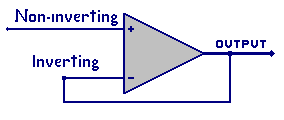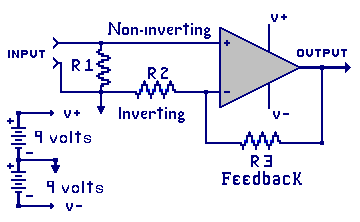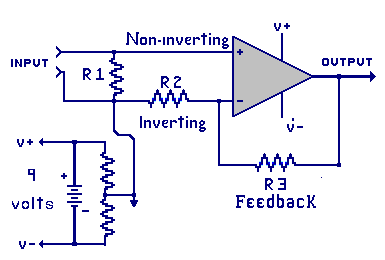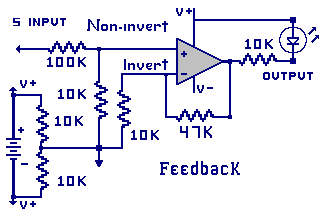
Introduction
Chapter 1 - Electricity
Chapter 1.2 - The Numbers
Chapter 2 Sharing and Bonding
Chapter 3 - Voltage
Chapter 3.2 Voltage Static
Chapter 3.3 - Batteries
Chapter 3.4 Solar - Others
Chapter 4 - Resistance
Chapter 4.2 Parallel Resistance
Chapter 4.3 Voltage Dividers
Chapter 5 - Semiconductor
Chapter 5.2 - PNP NPN Junctions
Chapter 6 AC and Hertz
Chapter 7 - Magnetism
Chapter 7.2 - Inductors
Chapter 8 - Capacitor
Chapter 9 - IC's and OP-AMP's
Chapter 9.2 - Feedback, Unity Gain
Chapter 9.3 - Non-inverting Amplifier
Chapter 9.4 - Inverting Amplifier
Chapter 10 - 555 Timer
Chapter 10.2 - 555 Timer- Part 2
Chapter 11 - Logic
Chapter 12 - The Power Supply
Chapter 12.2 - More on Power Supplies
|
|
 This configuration is a Non-inverting Operational Amplifier using a dual-rail
supply consists of two 9 volt batteries. The supply provides +9V (one rail),
with respect to the circuit common(ground) as well as a -9V (another rail).
This configuration is a Non-inverting Operational Amplifier using a dual-rail
supply consists of two 9 volt batteries. The supply provides +9V (one rail),
with respect to the circuit common(ground) as well as a -9V (another rail). Lets reexamine this same example and replace the input voltage steps with
a smooth SINE WAVE moving between -0.1V and +0.1 volts. I have graphed one cycle here.
This is called a 0.2 volts peak-to-peak input
signal. Because the speed of the Op Amps reaction to its changing
inputs is sufficiently fast, the output will also be
smooth with a 2.2 volt peak-to-peak output swing.
Lets reexamine this same example and replace the input voltage steps with
a smooth SINE WAVE moving between -0.1V and +0.1 volts. I have graphed one cycle here.
This is called a 0.2 volts peak-to-peak input
signal. Because the speed of the Op Amps reaction to its changing
inputs is sufficiently fast, the output will also be
smooth with a 2.2 volt peak-to-peak output swing.
 This configuration is a Non-inverting Opertional Amplifier using a single rail
supply consisting of one 9 volt battery. When using a single rail supply,
to replace the previous dual rail supply, there is a need to add another voltage
divider circuit to provide the reference point for circuit
common (ground) as supply mid-point. As drawn this circuit is using only 9 volts,
which replaced the 18 volts of the last example. With half the available supply voltage
the Op Amp is limited to half the output voltage swing. Note
that the supply is only 9 Volts, but could be
any reasonable voltage depending on the specifications of the Op Amp you choose.
The higher the potential of the power supply
voltage, a higher output voltage swing and a higher gain can be realized.
This configuration is a Non-inverting Opertional Amplifier using a single rail
supply consisting of one 9 volt battery. When using a single rail supply,
to replace the previous dual rail supply, there is a need to add another voltage
divider circuit to provide the reference point for circuit
common (ground) as supply mid-point. As drawn this circuit is using only 9 volts,
which replaced the 18 volts of the last example. With half the available supply voltage
the Op Amp is limited to half the output voltage swing. Note
that the supply is only 9 Volts, but could be
any reasonable voltage depending on the specifications of the Op Amp you choose.
The higher the potential of the power supply
voltage, a higher output voltage swing and a higher gain can be realized.

